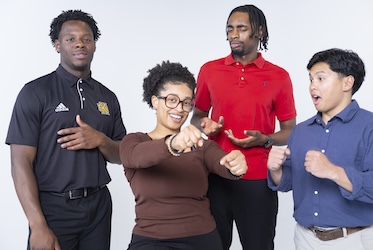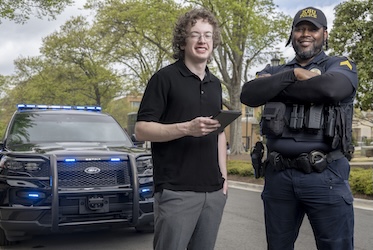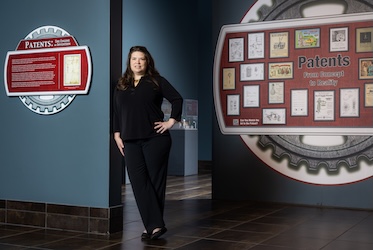
Best of Both Worlds
KENNESAW, Ga. | Jun 12, 2019
KSU computer game designers provide unique study aids
When the University of Georgia’s College of Veterinary Medicine began experimenting with video games to guide its students through concepts that were otherwise too difficult to visualize, it turned to a pool of talent uniquely positioned to answer the call: Kennesaw State University computer game design and development (CGDD) alumni.
Since the summer of 2015, an informal pipeline of game developers has formed between two of the state’s most unique academic offerings. Joshua Skelton, a 2014 graduate of the College of Computing and Software Engineering, was among the first to arrive when he accepted a full-time position as an interactive media developer within the College of Veterinary Medicine’s Educational Resources, a department focused on providing medical illustration, photography, animation and graphic arts services in support of the teaching, research and service missions of the veterinary college and UGA.

In addition to Skelton, three additional computer game design and development (CGDD) alumni now work as interactive media graduate assistants in the department, and a handful of other KSU students have completed internships there while finishing their studies. Together, the Kennesaw State graduates use their past studies to build applications, interactive games and virtual reality programs that serve as study aids for veterinary students, working closely with UGA faculty members to discuss how to best represent their course material in a virtual environment. It’s a partnership that has exceeded expectations, said Jim Moore, director of Educational Resources.
“This has been such a good match that it would have been unwise for the two universities to not to form this kind of relationship,” said Moore on pairing Georgia’s only veterinary school with graduates of the state’s only accredited game design program. “From my perspective, we’re bringing together the best of both worlds.”
Moore, who practiced veterinary medicine before becoming a professor, said he first learned the value of using medical illustrations and interactive media when he began teaching. Once he became director of Educational Resources, however, he was convinced that the department needed to start making material that would be engaging to today’s students.
His department began by creating iBooks, virtual books filled with graphics and videos that attempted to illustrate medical concepts that the students struggled to envision in their studies. Intent on creating material that urged students to learn instead of simply memorize the content, Moore said, the department shifted its focus toward building applications on the Unity platform, a staple in KSU’s CGDD curriculum.
“They really wanted to step up their technological game when they hired me,” Skelton said. “They had no background in software development, so I started by fixing old apps that weren’t working properly. After a while, we graduated from apps to full on virtual reality programs.”
As the projects grew in complexity, so did the workload. A short while later, the department added graduate assistant positions and sought to fill them with highly-trained KSU alumni.
“I felt like this was a great way for me to give back to my alma mater,” Skelton said. “I knew how tough it was to get your foot in the door for your dream job and how difficult it was to gain the necessary experience. This is a way for them to gain experience while also exposing them to a new world of career possibilities.”
Robert Forbes, an interactive media graduate assistant who graduated from KSU in May 2018, said his work within the veterinary college will serve as the cornerstone for his future job search. Since arriving at UGA, Forbes has been integral in the creation of several games including Bloodstream VR, an immersive virtual reality application that helps students learn about the cellular components in the bloodstreams of animals.

While at Kennesaw State, Forbes said he was introduced to Skelton and was immediately drawn to the broader applications of game development. Forbes [KSU grad, May 2018] has been integral in the creation of Bloodstream VR, an immersive virtual reality application that helps students learn about the cellular components in the bloodstreams of animals.
“This internship has totally changed my perception of how game design can be used in the world,” he said. “Now, I feel like I don’t need to look at video game companies for a career. For example, I could look at insurance companies and help them create a game to allow customers to figure out what insurance is best suited for them. The opportunities are limitless.”
Josh Williams, who started his internship with Educational Resources this past summer, said he receives a great deal of satisfaction in helping students learn. While a student at KSU, he took courses in educational game design that taught him how to interact with teachers and meet their expectations on projects. Using this knowledge, he is currently deeply involved in a virtual reality project that will teach undergraduate students the fundamentals of biochemistry.
“Knowing that I can help others with the technical skills I’ve acquired means the world to me,” Williams said. “If I can help digest this information in an easier, more fun way then I feel like I’ve done my job.”
A third CGDD alumnus, Michael Williams, joined Educational Resources in January with a host of projects already under his belt. As an undergraduate student at Kennesaw State, he helped build a mixed reality application to help veterinary students identify diseased bones in animals.

The biggest challenge of creating educational games is they must be both enjoyable and engaging, and students must leave with some kind of lesson, Moore said. With the help of KSU alumni, he said, his department has been able to check all of the boxes.
“The clients love the projects and are constantly wowed by them,” he said. “This is making all of the difference in our department. Our efforts in creating interactive media are certainly receiving some well-deserved recognition.”
– Travis Highfield
###
For more from Kennesaw State University Magazine, click here.
Related Stories

Kennesaw State to revive bathtub race tradition with new video game

Kennesaw State student develops AI tools to help first responders diagnose behavioral health issues

Kennesaw State computer game design student launches studio, first video game

Master's degree led Kennesaw State alumna to career as museum collection manager
A leader in innovative teaching and learning, Kennesaw State University offers undergraduate, graduate, and doctoral degrees to its more than 47,000 students. Kennesaw State is a member of the University System of Georgia with 11 academic colleges. The university’s vibrant campus culture, diverse population, strong global ties, and entrepreneurial spirit draw students from throughout the country and the world. Kennesaw State is a Carnegie-designated doctoral research institution (R2), placing it among an elite group of only 8 percent of U.S. colleges and universities with an R1 or R2 status. For more information, visit kennesaw.edu.














